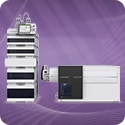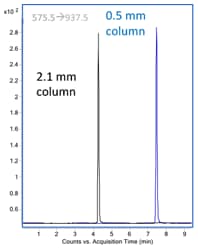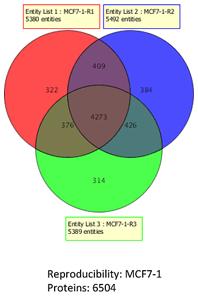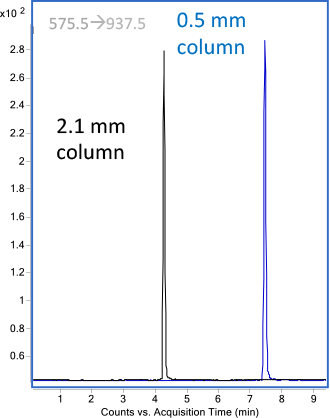Access Agilent eNewsletter June 2015
>> Update My Profile | Subscribe to Access Agilent | Article Directory

Agilent UHPLC delivers high-throughput, robust, and reproducible LC/MS analyses of complex proteomics samples
By Christine Miller and Mike Hagmaier
Agilent Omics Segment Marketing
Proteomics research typically uses nanospray LC/MS to achieve maximum sensitivity when sample amount is limited. Because electrospray ionization (ESI) produces high ionization efficiency and is concentration-dependent, small inside diameter (id) columns and low flow rates provide the best sensitivity. However, nanoflow LC/MS systems require more skill to use and maintain, and the limited nanocolumn capacity results in less robust chromatography.
The larger column id of ultra-high performance liquid chromatography (UHPLC) columns improves sample loading, but sensitivity typically has been a limitation for proteomics analyses. Now this paradigm has changed. Agilent high-performance mass spectrometers that incorporate iFunnel technology achieve new levels of sensitivity for peptides in complex matrices using standard-flow LC/MS.
iFunnel technology enhances sensitivity
Agilent iFunnel technology combines the efficient electrospray ion generation and focusing of Agilent Jet Stream technology with a hexabore capillary sampling array, to enable a much larger fraction of the ESI spray plume to enter the mass spectrometer ion optics. [1] A unique dual-stage ion funnel increases ion transmission and greatly improves signal-to-noise. Agilent Jet Stream thermal gradient focusing technology significantly enhances sensitivity by improving the desolvation and spatial focusing of ions. [2] Superheated nitrogen sheath gas confines the nebulizer spray, to effectively dry ions and concentrate them in a thermal confinement zone. On average, you can achieve a 5- to 10-fold improvement in MS and MS/MS sensitivity.
 Enlarge
Enlarge
Figure 1. Capillary flow LC/MS (blue) versus standard flow LC/MS (black) with 1 fmol on-column of LVNEVTEFAK. The Agilent Jet Stream source can accept the greater flow rate of the more robust 2.1 mm column.
 Enlarge
Enlarge
Figure 2. Outstanding sensitivity of the Agilent 6495 QQQ with UHPLC using a synthetic peptide standard spiked into an enolase tryptic digest. At the lower limit of quantitation (LLOQ), reproducibility was 14% (n = 10) and accuracy was 109.8%.
 Enlarge
Enlarge
Figure 3. Excellent reproducibility between technical replicates.
Even better sensitivity with Jet Stream
At a capillary flow rate of 15 µL/min, the Agilent Jet Stream source provides greater than three-fold signal enhancement for peptides versus ESI. [3] Furthermore, Jet Stream technology shows a mass-sensitive response (sensitivity proportional to amount of sample introduced into the source), which allows the use of more robust chromatographic separations on 2.1 mm id columns without sacrifice of sensitivity (Figure 1). [4]
Nanoflow LC/MS provides about 10-fold lower detection levels due to the high ionization efficiency and proximity of the nanospray to the MS inlet, but you can mitigate this sensitivity difference by simply injecting more sample. As demonstrated in human plasma [5], loading 10-fold more plasma on a standard-flow LC/MS system with a Jet Stream source resulted in equal or better sensitivity for 72 of the 81 target peptides.
Quantitative proteomics on a triple quadrupole MS
For complex biological matrixes, the improved chromatographic performance with standard-flow LC/MS provides significant improvement in the overall analysis. [6] Agilent triple quadrupole mass spectrometers interfaced to an Agilent 1290 Infinity II LC system through the Jet Steam source provide high sensitivity, robustness, and outstanding retention time stability. With the Agilent 6495 Triple Quadrupole LC/MS with iFunnel technology and the Agilent Jet Stream source, you can achieve low attomole limits of detection (LODs) for peptides, which enables routine, high-sensitivity peptide quantitation (Figure 2).
Discovery proteomics on a Q-TOF
With Agilent Jet Stream technology and the Agilent 6550 iFunnel Q-TOF LC/MS system, it is now feasible to use UHPLC for discovery proteomics when sample amount is not limiting. [7] This high-throughput UHPLC/MS analysis has been applied to a set of four different human glioblastoma (GBM) cell lines using a 30-minute gradient. At the 1% false discovery rate (FDR) level, 4,264 unique human proteins and 24,916 unique peptides were identified in a preliminary analysis. The reproducibility between technical replicates (n=3) showed that 94% were identified in at least two of the three replicates, and 64% of the proteins were identified in all replicates (Figure 3).
Enhance your proteomics research
Agilent provides all the essential tools for discovery and targeted proteomics research. Explore the complete line of Agilent proteomics instrument and software products in our proteomics brochure.
References
- Mordehai, A; Fjeldsted, J. “Agilent Jet Stream Thermal Gradient Focusing Technology” Agilent Technical Note 5990-3494EN, 2009.
- Momoh, P; et al. “iFunnel Technology for Enhanced Sensitivity in Tandem LC/MS” Agilent Technical Overview 5990-5891EN, 2010.
- Love, C; Miller, C. A; Mordehai, A. “Using Thermal Gradient Focusing ESI to Develop Sensitive, High-Throughput Capillary Flow LC/MS/MS Peptide Quantitation AssAss“ ASMS 2011.
- Buckenmaier, S; Miller, CA; van de Goor, T; Dittmann, MM. (2015), "Instrument contributions to resolution and sensitivity in ultra highperformance liquid chromatography using small bore columns: Comparison of diode array and triple quadrupole mass spectrometry detection“ J Chromatogr. A, 1377:64-74.
- Percy, A. J; et al. “Comparison of standard- and nano-flow liquid chromatography platforms for MRM-based quantitation of putative plasma biomarker proteins“ Anal. Bioanal. Chem. 2012, 404(4), pp 1089-1101.
- Domanski, D; et al. “High-flow multiplexed MRM-based analysis of proteins in human plasma without depletion or enrichment“ Clin. Lab. Med. 2011, 31(3), pp 371-384.
- Yang, Y; Bhat, V; Miller, C. “Jet Stream Proteomics for Sensitive and Robust Standard Flow LC/MS” Agilent Technical Overview 5991-5687EN, 2015.
>> Update My Profile | Subscribe to Access Agilent | Article Directory
Figure 1.

Capillary flow LC/MS (blue) versus standard flow LC/MS (black) with 1 fmol on-column of LVNEVTEFAK. The Agilent Jet Stream source can accept the greater flow rate of the more robust 2.1 mm column.

